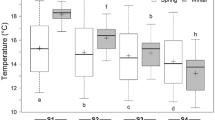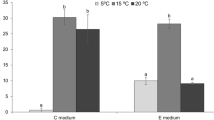Abstract
Frequency and amplitude of temperature oscillations can profoundly affect structure and function of ecosystems. Unless the rate of a biological process changes linearly within the range of these fluctuations, the cumulative effect of temperature differs from the effect measured at the average temperature (Jensen's inequality). Here, we measured numbers and types of spores released by aquatic hyphomycetes from oak and alder leaves that had been exposed in a Portuguese stream for between 7 and 94 days. Recovered leaves were incubated at four temperatures between 5 and 20 °C. Over this range, the sporulation response to temperature was decelerating, with an estimated optimum around 12.5 °C. Assuming a linear response, therefore, overestimates spore release from decaying leaves. The calculated discrepancy was more pronounced with recalcitrant oak leaves (greater toughness, phenolics concentration, lower N and P concentration than alder), and reached 26.6 % when temperature was assumed to oscillate between 1 and 9 °C, rather than remaining constant at 5 °C. The maximum fluctuation of water temperature over 48 h during the field experiment was approximately 3 °C, which would result in a discrepancy of up to 6 %. The composition of the fungal community (assessed by species identification of released spores) was significantly influenced by the state of decomposition, but not by leaf species or temperature. When quantifying the potential impact of global change on aquatic fungal communities, the average increase as well as fluctuations of the temperature have to be considered.






Similar content being viewed by others
References
Vannote RL, Minshall GW, Cummins KW, Sedell JR, Cushing CE (1980) The river continuum concept. Can J Fish Aquat Sci 37:130–137
Webster JR, Benfield EF (1986) Vascular leaf breakdown in freshwater ecosystems. Annu Rev Ecol Syst 17:567–594
Bärlocher F, Stewart M, Ryder DS (2011) Analyzing aquatic fungal communities in Australia: impacts of sample incubation and geographic distance of streams. Czech Mycol 63:113–132
Bärlocher F, Stewart M, Ryder DS (2012) Processing of Eucalyptus viminalis leaves in Australian streams—importance of aquatic hyphomycetes and zoosporic fungi. Fundam Appl Limnol 179:305–319
Gessner MO, Gulis V, Kuehn KA, Chauvet E, Suberkropp K (2007) Fungal decomposers of plant litter in aquatic ecosystems. In: Kubicek CP, Druzhinina IS (eds) The mycota, volume IV: environmental and microbial relationships, 2nd edn. Springer, Berlin, pp 301–324
Krauss G-J, Solé M, Krauss G, Schlosser D, Wesenberg D, Bärlocher F (2011) Fungi in freshwaters: ecology, physiology and biochemical potential. FEMS Microbiol Rev 35:620–651
Bärlocher F (1992) Research on aquatic hyphomycetes: historical background and overview. In: Bärlocher F (ed) The ecology of aquatic hyphomycetes. Springer, Berlin, pp 1–15
Chandrashekar KR, Sridhar KR, Kaveriappa KM (1991) Aquatic hyphomycetes from a sulphur spring. Hydrobiologia 218:151–156
Rajashekar M, Kaveriappa KM (2000) Effects of temperature and light on growth and sporulation of aquatic hyphomycetes. Hydrobiologia 441:149–153
Eaton JG, Scheller RM (1996) Effects of climate warming on fish thermal habitat in streams on the United States. Limnol Oceanogr 41:1109–1115
Morrill JC, Bales RC, Conklin MH (2005) Estimating stream temperature from air temperature: implications for future water quality. J Env Engineer 131:139–146
Bärlocher F, Seena S, Wilson KP, Williams DD (2008) Raised water temperature lowers diversity of hyporheic aquatic hyphomycetes. Freshw Biol 53:368–379
IPCC [International Panel on Climate Change] (2007) Climate change 2007: the physical science basis. Contribution of working group I to the fourth assessment report of the intergovernmental panel on climate change. Solomon S, Qin D, Manning M, Chen Z, Marquis M, Averyt KB, Tignor M, Miller ML (eds). Cambridge University Press, Cambridge
Easterling DR, Horton B, Jones PD, Peterson TC, Karl TR, Parker DE, Salinger MJ, Razuvayev V, Plummer N, Jamason P, Folland CK (1997) Maximum and minimum temperature trends for the globe. Science 277:364–367
Ruel JJ, Ayres MP (1999) Jensen's inequality predicts effects of environmental variation. Tr Ecol Evol 14:361–366
Dang CK, Schindler M, Chauvet E, Gessner MO (2009) Temperature oscillation coupled with fungal community shifts can modulate warming effects on litter decomposition. Ecology 90:122–131
Conant RT, Drijber RA, Haddix ML, Parton WJ, Paul EA, Plante AF, Six J, Steinweg JM (2008) Sensitivity of organic matter decomposition to warming varies with its quality. Global Change Biol 14:868–877
Fierer N, Crane JM, McLauchlan K, Schimel JP (2005) Litter quality and the temperature sensitivity of decomposition. Ecology 86:320–326
Bosatta E, Ågren GI (1999) Soil organic matter quality interpreted thermodynamically. Soil Biol Biochem 31:1889–1891
Allan JD, Castillo MM (2007) Stream ecology. Structure and function of running water, 2nd edn. Springer, Dordrecht
Graça MAS, Bärlocher F, Gessner MO (2005) Methods to study litter decomposition. A practical guide. Springer, Dordrecht
Gessner MO, Chauvet E (1993) Ergosterol-to-biomass conversion factors for aquatic hyphomycetes. Appl Environ Microbiol 59:502–507
Motulsky HJ, Christopoulos A (2004) Fitting models to biological data using linear and nonlinear regression. A practical guide to curve fitting. Oxford University Press, New York
Anderson MJ (2003) PCO: a FORTRAN computer program for principal coordinate analysis. Department of Statistics, University of Auckland, New Zealand. http://www.stat.auckland.ac.nz/~mja/Programs.htm, accessed 5 June 2012.
Anderson MJ, Willis TJ (2003) Canonical analysis of principal components: a useful method of constrained ordination for ecology. Ecology 84:511–525
Anderson MJ (2004) CAP: a FORTRAN computer program for canonical analysis of principal coordinates. Department of Statistics, University of Auckland, New Zealand. http://www.stat.auckland.ac.nz/~mja/Programs.htm, accessed 5 June 2012.
Webb BW, Walling DE (1985) Temporal variation of river water temperatures in a Devon river system. Hydrol Sci J 30:449–464
Hynes HBN (1970) The ecology of running waters. University of Toronto Press, Toronto
Caissie D (2006) The thermal regime of rivers: a review. Freshw Biol 51:1389–1406
Constantz JJ (1998) Interaction between stream temperature, streamflow, and groundwater exchanges in alpine streams. Water Resour Res 34:1609–1615
Durance I, Ormerod SJ (2009) Trends in water quality and discharge confound long-term warming effects on river macroinvertebrates. Freshw Biol 54:388–405
Sutherland WJ, Bailey MJ, Bainbridge IP, Brereton T, Dick JTA, Drewitt J, Dulvy NK, Dusic NR, Freckleton RP, Gaston KJ, Gilder PM, Green RE, Heathwaite AL, Johnson SM, Macdonald DW, Mitchell R, Osborn D, Owen RP, Pretty J, Prior SV, Prosser H, Pullin AS, Rose P, Stott A, Tew T, Thomas CD, Thompson DBA, Vickery JA, Walker M, Walmsley C, Warrington S, Watkinson AR, Williams RJ, Woodroffe R, Woodroof HJ (2008) Future novel threats and opportunities facing UK biodiversity identified by horizon scanning. J Appl Ecol 4:821–833
Sridhar KR, Bärlocher F (1993) Aquatic hyphomycetes on leaf litter in and near a stream in Nova Scotia, Canada. Mycol Res 97:1530–1535
Bruder A, Chauvet E, Gessner MO (2011) Litter diversity, fungal decomposers and litter decomposition under simulated stream intermittency. Funct Ecol 25:1269–1277
Schlief J, Mutz M (2011) Leaf decay processes during and after a supra-seasonal hydrological drought in a temperate lowland steam. Internat Rev Hydrobiol 6:633–655
Kuehn KA, Suberkropp K (1998) Diel fluctuations in rates of CO2 evolution from standing dead leaf litter of the emergent macrophyte Juncus effusus. Aquat Microb Ecol 14:171–182
Fernandes I, Uzun B, Pascoal C, Cássio F (2009) Responses of aquatic fungal communities on leaf litter to temperature-change events. Internat Rev Hydrobiol 94:410–418
Canhoto C, Graça MAS (1996) Decomposition of Eucalyptus globulus leaves and three native leaf species (Alnus glutinosa, Castanea sativa and Quercus faginea) in a Portuguese low order stream. Hydrobiologia 333:79–85
Ferreira V, Elosegi A, Gulis V, Pozo J, Graça MAS (2006) Eucalyptus plantations affect fungal communities with leaf-litter decomposition in Iberian streams. Arch Hydrobiol 166:467–490
Ferreira V, Gulis V, Graça MAS (2006) Whole-stream nitrate addition affects litter decomposition and associated fungi but not invertebrates. Oecologia 149:718–729
Güsewell S, Gessner MO (2009) N:P ratios influence litter decomposition and colonization by fungi and bacteria in microcosms. Funct Ecol 23:211–219
Gessner MO, Chauvet E (1994) Importance of stream microfungi in controlling breakdown rates of leaf litter. Ecology 75:1807–1817
Suberkropp K (2000) Estimating production of litter-decomposing fungi in streams from rates of acetate incorporation into ergosterol. Verh Internat Verein Limnol 27:2426–2429
Suberkropp K, Klug MJ (1980) The maceration of deciduous leaf litter by aquatic hyphomycetes. Can J Bot 58:1025–1031
Bärlocher F (2009) Reproduction and dispersal in aquatic hyphomycetes. Mycoscience 50:3–8
Bärlocher F (1981) Fungi on the food and in the faeces of Gammarus pulex. Trans Br Mycol Soc 76:160–165
Bärlocher F, Brendelberger H (2004) Clearance of aquatic hyphomycete spores by a benthic suspension feeder. Limnol Oceangr 49:2292–2296
Chauvet E, Suberkropp K (1998) Temperature and sporulation of aquatic hyphomycetes. Appl Environ Microbiol 64:1522–1525
Koske RE, Duncan IW (1974) Temperature effects on growth, sporulation, and germination of some “aquatic” hyphomycetes. Can J Bot 52:1387–1391
Singh N, Musa TM (1977) Terrestrial occurrence and the effect of temperature on growth, sporulation and spore germination, of some tropical aquatic hyphomycetes. Trans Br Mycol Soc 68:103–106
Webster J, Moran SI, Davey RA (1976) Growth and sporulation of Tricladium chaetocladium and Lunulospora curvula in relation to temperature. Trans Br Mycol Soc 67:491–549
Ingold CT (1942) Aquatic hyphomycetes of decaying alder leaves. Trans Br Mycol Soc 25:339–417
Pascoal C, Cássio F (2008) Linking fungal diversity to the functioning of freshwater ecosystems. In: Sridhar KR, Bärlocher F, Hyde KD (eds) Novel techniques and ideas in mycology. Fung Div Res Ser 20:1–19
Acknowledgments
We thank Ana Lírio for assistance in the field and the laboratory. Financial support by the Portuguese Science and Technology Foundation (FCT) to ALG (reference SFRH/BD/47089/2008) is gratefully acknowledged. This manuscript was supported by the FEDER Funds through the Program Operational Factors of Competitiveness (COMPETE) and National Funds through the Portuguese Science and Technology Foundation (FCT, project PTDC/CLI/67180/2006).
Author information
Authors and Affiliations
Corresponding author
Rights and permissions
About this article
Cite this article
Bärlocher, F., Kebede, Y.K., Gonçalves, A.L. et al. Incubation Temperature and Substrate Quality Modulate Sporulation by Aquatic Hyphomycetes. Microb Ecol 66, 30–39 (2013). https://doi.org/10.1007/s00248-013-0202-7
Received:
Accepted:
Published:
Issue Date:
DOI: https://doi.org/10.1007/s00248-013-0202-7




